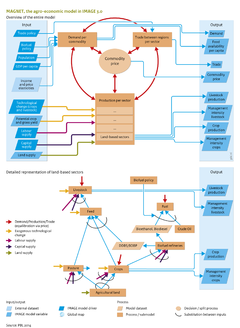Agricultural economy: Difference between revisions
Jump to navigation
Jump to search
No edit summary |
No edit summary |
||
| Line 7: | Line 7: | ||
|InputVar=Population; GDP per capita; Capital supply; Labor supply; Trade policy; Biofuel policy; Land supply; Crop and grass yield - grid; Technological change (crops and livestock); Income and price elasticities of agricultural commodities demand; Land for bioenergy; | |InputVar=Population; GDP per capita; Capital supply; Labor supply; Trade policy; Biofuel policy; Land supply; Crop and grass yield - grid; Technological change (crops and livestock); Income and price elasticities of agricultural commodities demand; Land for bioenergy; | ||
|OutputVar=Crop production; Management intensity crops; Management intensity livestock; Food availability per capita; Commodity price; Livestock production; Demand (crop and lifestock); Trade (crop and livestock); | |OutputVar=Crop production; Management intensity crops; Management intensity livestock; Food availability per capita; Commodity price; Livestock production; Demand (crop and lifestock); Trade (crop and livestock); | ||
|Description= | |Description=As a result of the growing world population and higher per capita consumption, production of food, feed, fibres and other products, such as bio-energy and timber will need to increase rapidly in the coming decades. Even with the expected improvements in agricultural yields and efficiency, there will be increasing demand for more agricultural land. However expansion of agricultural land will lead to increases in greenhouse gas emissions, loss of biodiversity and ecosystem services, and nutrient imbalances. To reduce these environmental impacts, action is needed urgently to increase agricultural yields further and to reduce deforestation requires political support. | ||
In IMAGE, | In IMAGE, future development of the agricultural economy can be calculated using the agro-economic model [[MAGNET model|MAGNET]] (formerly LEITAP) ([[Woltjer et al., 2011]]). MAGNET is a computable general equilibrium ([[CGE]]) model that is connected via a soft link to the core model of IMAGE. | ||
Demographic changes and rising incomes are the primary driving factors of the model, and lead to increasing and changing demand for all commodities including agricultural commodities. In response to changing demand, agricultural production is increasing, and the model also takes into account changing prices of production factors, resource availability and technological progress. In MAGNET, agricultural production supplies domestic markets, and other countries and regions are supplied via international trade, depending on historical trade balances, competitiveness (relative price developments), transport costs and trade policies. | |||
MAGNET uses information from IMAGE on land availability and suitability, and on changes in crop yields due to climate change and agricultural expansion on inhomogeneous land areas. The results from MAGNET on production and endogenous yield (management factor) are used in IMAGE to calculate spatially explicit land-use change, and the environmental impacts on carbon, nutrient and water cycles, biodiversity, and climate. | |||
Although MAGNET is the standard agro-economic model used with IMAGE, other models can be linked with IMAGE. For example, the IMPACT model was used with IMAGE in the Millennium Ecosystem Assessment ([[Carpenter, 2006]]), and in a PBL study on protein supply, both the MAGNET and the IMPACT model were used to study the same set of scenarios. This allowed a systematic comparison between IMPACT and MAGNET ([[Stehfest et al., 2013]]). | |||
In IMAGE, demand for forest products can be derived from several sources, the most simplest being via a relationship with GDP or preferably, from specific forest demand models, such as [[EFIGTM model|EFI-GTM]] ([[Kallio et al., 2004]]). In the future, competition between forestry and other land uses can be included using the forestry module in MAGNET. Other land-use changes, such as infrastructure expansion, which do not require interregional links, are described in the land-use allocation module [[Agricultural systems]]. | |||
|ComponentCode=AEF | |ComponentCode=AEF | ||
|AggregatedComponent=Agriculture and land use | |AggregatedComponent=Agriculture and land use | ||
|FrameworkElementType=pressure component | |FrameworkElementType=pressure component | ||
}} | }} | ||
Revision as of 17:44, 10 February 2014
Parts of Agricultural economy
| Component is implemented in: |
|
| Related IMAGE components |
| Projects/Applications |
| Key publications |
| References |
Key policy issues
- What is the area of cropland and grassland required to support future food demand?
- What are the policy options to reduce agricultural land use and to safeguard global biodiversity, while ensuring food security?
- How can the implications of biofuels for land use and greenhouse gases be managed sustainably?
